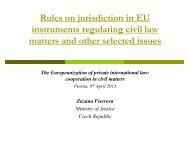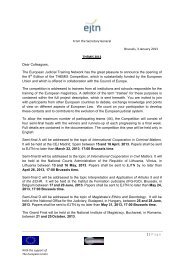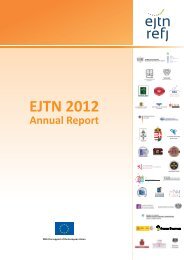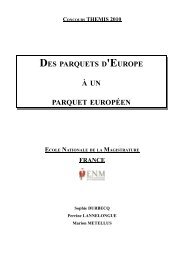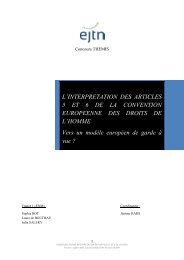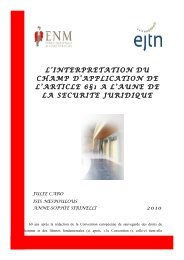European Criminal Justice - EJTN
European Criminal Justice - EJTN
European Criminal Justice - EJTN
- No tags were found...
Create successful ePaper yourself
Turn your PDF publications into a flip-book with our unique Google optimized e-Paper software.
<strong>EJTN</strong> training guideline in <strong>European</strong> <strong>Criminal</strong> <strong>Justice</strong> - Update 2011The recommended training method would be specialised seminars andworkshopsB) Complementary e-learning: recommendedC) Priority:Training on these instruments should have priorityTraining on this topic has been selected to form part of a common nationaltraining curriculum in <strong>European</strong> criminal justice by the participating trainers ofthe joint Workshop 'A joint frame for <strong>European</strong> criminal justice training in theEU'.D) Format:Training should take place on a national, trans-national and EU-wide level.VI. Ne bis in idem, transfer of criminal proceedings andconflicts of jurisdiction1. IntroductionThe Council of Europe Convention on the Transfer of Proceedings in criminalmatters was adopted in 1972. Yet, only thirteen Member States have ratified it.As a result, a number of other Member States rely only, for the purposes ofenabling other Member States to bring proceedings, on the mechanism of the1959 Council of Europe Convention on Mutual Legal Assistance in <strong>Criminal</strong>Matters, in connection with the Convention on Mutual Legal Assistance in<strong>Criminal</strong> Matters between the Member States of the <strong>European</strong> Union from 2000.However, as this mechanism is far from providing the same effects as the oneresulting from the Council of Europe’s Convention indicated above, the mostfrequently tool used to that end consists in the establishment of bilateral ad-hocagreements, under the reciprocity rule, when the national laws involved providethat possibility.Between the Member States of the <strong>European</strong> Communities an agreement on thetransfer of proceedings in criminal matters was also signed in 1990, which hasnot, however, entered into force due to lack of ratifications. Accordingly, nocommon legal framework on the procedure of transfer of proceedings with e.g.,criteria for requesting transfer, a procedure following a request, reasons forrefusing a request and effects of a transfer, exists. In line with the aim ofcreating a common <strong>European</strong> area of freedom, security and justice, severalMember States deemed it necessary to take action to eliminate the deficits ofthe absence of such framework. Their proposal for a Framework Decision aims toachieve the better determination of the place of the criminal proceedings andthe increase transparency and greater objectivity in the way in which the placefor the trial is chosen.The principle of ne bis in idem is particular to criminal law; recognized at bothnational and international levels, initiating proceedings or reopening ajudgment against the same person a second time is barred for the same offenceor by courts of the same state. The principle of ‘ne bis in idem’ is acknowledged39



